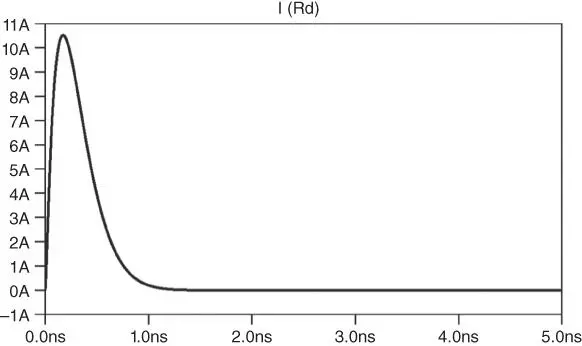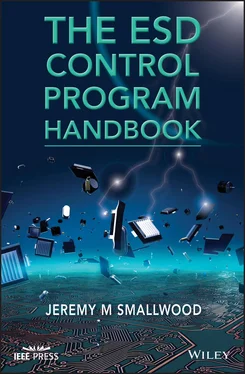
Practical ESD sources often require the addition of more components (e.g. additional capacitors) to better represent additional charge storage (e.g. metal parts) and other features that may be present. These may contribute further current peaks or modify the shape of the waveform (Verhage et al. 1993).
The stored energy E ESDin a conductive ESD source is given by


Figure 2.23Simulated underdamped device ESD current waveform for the case of low circuit resistance (dominant inductive and capacitive impedance): R ESD= 10 Ω, R d= 10 Ω, L s= 750 nH, C s= 200 pF, V ESD= 500 V.

Figure 2.24Simulated device ESD current waveform for near critical damping: R ESD= 20 Ω, R d= 10 Ω, L s= 2.5 nH, C s= 10 pF, V ESD= 500 V.
All this energy is dissipated in the total circuit resistance R . Only a fraction of this is the energy dissipated in the device E d.

In a source such as the charged human body that has significant resistance, most of the stored energy is dissipated in the circuit (body) resistance, and only a small fraction is dissipated in the victim device. In contrast, a charged metal object is a low‐resistance ESD source, and most of the stored energy can be dissipated in the victim device. This is one reason why some components may be damaged by a lower voltage with a metal ESD source compared to a charged person. In general, the likelihood of ESD damage to a component by ESD from a source will depend on the susceptibility of the device to ESD current, voltage, energy, or other parameter of the discharge. This is further discussed in Chapter 3.
2.8 Electrostatic Attraction (ESA)
Where there is an electrostatic field, charged particles in the vicinity will experience an attractive or repulsive force. A lesser known effect is that uncharged particles can be attracted or repelled in a convergent or divergent field – this is known as dielectrophoresis (Cross 2012).
The direction of the force depends on the polarity of the charged particles and the field. The force acts such that like polarity charges repel and unlike polarity attract. So, a positive charge will experience a force toward a more negative potential, and vice versa.
2.8.1 ESA and Particle Contamination
These effects can be important where cleanliness of the product is essential. In a clean room for wafer fabrication, an electrostatic field can cause charged dust particles that are present to be transported to a wafer within the field. Particle contamination can then cause loss of product yield (Welker et al. 2006).
Other processes in which product cleanliness is important can include
Manufacture of flat‐screen displays. Loss of even a small number of pixels due to contamination can result in rejection of the product.
Packing of consumer products where dust or particle contamination can mar the appearance of the product before purchase.
Assembly of optical systems where performance can be reduced by contamination.
Assembly of medical systems where infection of the user may be a risk.
2.8.2 Neutralization of Surface Voltages by Air Ions
Clean air is naturally a good insulator with very few mobile charged particles present. A small number of ions are naturally generated when air molecules are split into positive and negative ions by the action of natural radioactivity or cosmic rays (Jonassen 2016a). These ions will be repelled or attracted by surface charges due to the electrostatic field. The ions move in the direction of the electrostatic field.
The charge migration rate and direction are dependent on the ion charge and other factors, as well as the electrostatic field strength and direction at the point in space where the ion is located. In still air, the ion drift velocity v dis related to electrostatic field E by the ion mobility μ.

The mobility of the ion is dependent on the ion size. In air, charges bind to water, nitrogen, and other molecules or particles and form small or large ions. Small ions have mobility in the range 1−2 × 10 −4m 2V −1s −1(Jonassen 2016a). Large ions have mobility in the range 8 × 10 −7to 3 × 10 −8m 2V −1s −1.
The number of air ions present can be increased using an ionizer. These produce air ions by various means such as corona discharge, radioactive, or X‐ray ionization of the air. Radioactive and X‐ray ionization sources provide both polarity ions by splitting air molecules into positive and negative ions.
Corona discharge sources use a high voltage applied to a sharp electrode (e.g. needle) to produce ions of one polarity. A nearly balanced ion source can be produced by this method by using an alternating current (AC) high voltage or two separate sources of opposite polarity.
A charged surface produces an electrostatic field surrounding it that repels like polarity ions and attracts opposite polarity ions. That is, a negatively charged surface repels negative ions and attracts positive ions. A positively charged surface attracts negative ions and repels positive ions. Opposite polarity ions will drift to the charged surface at a rate proportional to the field strength and in numbers proportional to the ion concentration. An opposite polarity charge on reaching the charged surface neutralizes an equal charge, reducing the net surface charge and electrostatic field. The ion drift represents a neutralizing current, limited by the ion concentration and field strength.
Ionizers are devices used to generate air ions for neutralization of surface charges on charged materials and objects (Jonassen 2016a, 2016b). These are available in various types based on passive, radioactive, electrical, and other principles of operation.
Passive ionizers rely on high electric fields developed around sharp points or edges on earthed conductors to generate air ions by corona discharge. These will always generate ions of the opposite polarity to the voltage producing the field at the point or edge. Unfortunately, corona discharges do not occur below a threshold field strength, and this means there is a threshold voltage, known as the corona inception voltage , below which ions are not produced, and neutralization does not occur. This threshold voltage may be several kilovolts (kV). This means that passive ionizers cannot be used to reduce voltages to below this threshold, and they are seldom useful in ESD control in electronics manufacture. They do find major applications in industrial processes such as plastic film manufacturing, printing, copiers, and other processes involving insulating materials.
Electrical ionizers also use the high electrostatic fields at points, usually needles, to generate air ions. In this case, however, a power supply is used to raise the needle to a voltage above the corona inception voltage to ensure that sufficient ions are produced. A balanced ion source with equal numbers of positive and negative ions is usually required. This can be produced either by using an AC driving voltage or by using two sets of needles, one at positive voltage and the other at negative voltage. This can produce an ion stream that is nearly balanced, but it is difficult to produce an exact balanced ion stream by this method.
Читать дальше


















